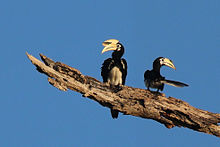Oriental pied hornbill
| Oriental pied hornbill | |
|---|---|
 |
|
| Male (left) and female (right) Kinabatangan River, Borneo |
|
| Scientific classification | |
| Kingdom: | Animalia |
| Phylum: | Chordata |
| Class: | Aves |
| Order: | Bucerotiformes |
| Family: | Bucerotidae |
| Genus: | Anthracoceros |
| Species: | A. albirostris |
| Binomial name | |
|
Anthracoceros albirostris (Shaw & Nodder, 1807) |
|
The oriental pied hornbill Anthracoceros albirostris is an Indo-Malayan pied hornbill, a large canopy-dwelling bird belonging to the Bucerotidae family. Two other common names for this species are sunda pied hornbill (convexus) and Malaysian pied hornbill. The species is considered to be among the smallest and most common of the Asian hornbills. It has the largest distribution in the genus and is found in the Indian Subcontinent and throughout Southeast Asia. Its natural habitat is subtropical or tropical moist lowland forests. The oriental pied hornbill's diet includes fruit, insects and small reptiles.
The Oriental hornbill, of the family Bucerotidae, belongs to the genus Anthracoceros, which consists of five species. Species in this genus are divided into two groups, Indo-Malayan pied hornbills and black hornbills.A. albirostris is grouped under the Indo-Malayan pied hornbills, based on plumage similarities, along with the Indian pied hornbill (A. coronatus) and the Palawan hornbill (A. marchei). The black hornbills include A. malayanus and A. montani.A. albirostris can be further categorized into two subspecies, A. a. albirostris and A. a. convexus.
The oriental pied hornbill is a medium size frugivore with a head-to-tail length of 55–60 cm from head to tail and a wingspan of 23–36 cm. The bill measures 19 cm for males and 16 cm for females. It can weigh between 600 g and 1,050 g, averaging 900 g for males and 875 g for females. The plumage of the head, neck, back, wings and upper breast is black with a slight green sheen. The tail is black with white tips on all the feathers except the central feathers (rectories). The plumage of their lower breast, lower abdomen, thighs, under-wing and all the tips of the wings except the three basal secondaries and two outer primaries is white, as is the circumorbital skin around the eyes and on the throat skin. A blue tinge can sometimes be noticed on the throat of adults. Casques of mature A. albirostri are laterally flattened “cylinders”, which may form a protruding horn. Males and females are similar in coloration. Males can be distinguished from females by their larger body size, yellow bill, which has a black base, and bright red eyes. Females have a slightly smaller body size, a yellow bill and casque with a partly black, browned patched mandible, and grayish-brown eyes. Juvenile A. albirostris resemble the adults, but have an undeveloped casque and a smaller bill. Their black plumage lacks the green gloss found on adults.
...
Wikipedia

